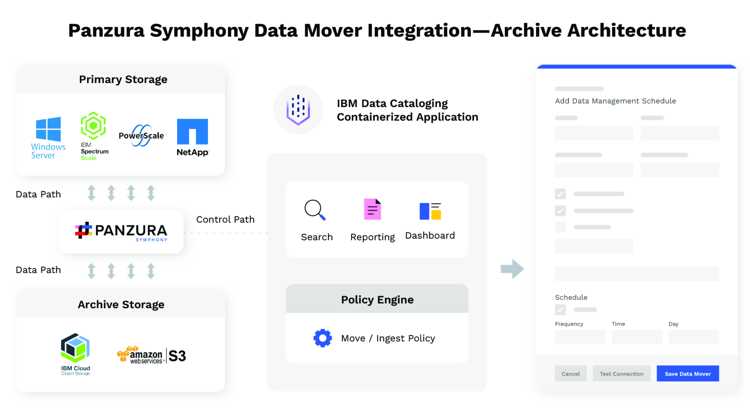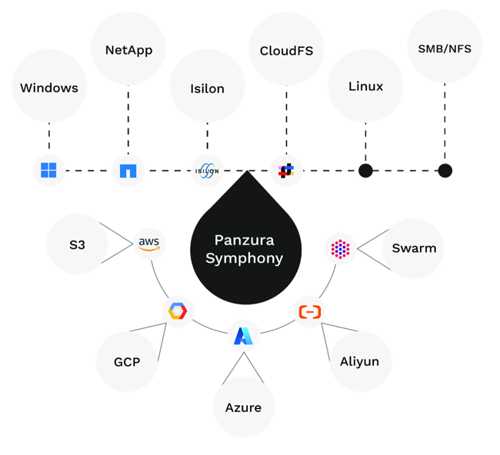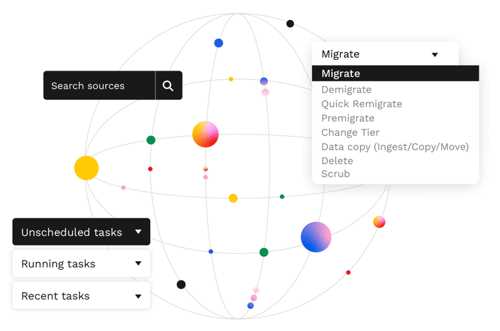Panzura Symphony to Harmonize Data Complexity with Business Outcomes
Offers vendor-certified data operations under single pane of glass with support for various file system deployments and protocols, and on-premises, private, public, and hybrid cloud object storage including major providers like AWS, Microsoft Azure, GCP, and Wasabi Hot Cloud Storage.
This is a Press Release edited by StorageNewsletter.com on October 9, 2024 at 2:00 pmSummary:
- Panzura has launched Symphony, a data services platform that harmonizes unstructured data complexities with business outcomes. It offers data operations under a single pane of glass, supporting file system deployments and on-premises and hybrid cloud storage.
- Symphony helps organizations drive agility and control with a unified dashboard and responsive UI. ITOps and line-of-business leaders can perform automated, EB-scale data discovery and assessment, risk and compliance analysis, and dynamic data movement orchestration.
- The platform optimizes data placement, transformation, and restructuring for AI workflows, enabling faster analysis from collection to deployment. It equips DevOps teams with webhooks, APIs, post-run actions, and relational database integration for handling large data volumes.
- Symphony augments the data operations capabilities of the company’s Data Services and complements the functionality of Panzura CloudFS. It extends the firm’s hybrid cloud portfolio to the fullest range of file data for which organizations need synchronous visibility and control.
Panzura LLC has unveiled Symphony, a data services platform designed to harmonize the complexities of unstructured data with business outcomes.
Symphony offers vendor-certified data operations under a single pane of glass with support for various file system deployments and protocols, and on-premises, private, public, and hybrid cloud object storage including major providers like AWS, Microsoft Azure, GCP, and Wasabi Hot Cloud Storage.
It allows enterprise organizations to drive radical agility and control in their IT and data stakeholder operations. With a unified dashboard and responsive user interface, the platform enables ITOps and line-of-business leaders to perform automated, EB-scale data discovery and assessment, risk and compliance analysis, and dynamic data movement orchestration.
Governance and management policies can be applied in seconds for file and object data inspection to empower insights and reporting, data mobilization and archive, and workflow and AI pipeline automation integration for DevOps support. Transparent to users and applications, original namespace, security, and file metadata is preserved, providing autonomous streaming of content on demand. The result is reduced storage costs, efficient workflows, and more proactive and compliant data posture.
“Panzura Symphony brings together proven technology and Panzura’s future vision where data management meets strategy for business success,” said Dan Waldschmidt, CEO, Panzura.
The platform builds on the company’s acquisition of Moonwalk Universal Inc. as the next-gen of the former Moonwalk solution with a new and expanding tool set.
 Symphony augments the data operations capabilities of Panzura Data Services, which provides data visibility, governance, and real-time access across ecosystems, and complements the functionality of Panzura CloudFS, a hybrid cloud file services platform that supports large-scale multi-site workflows for the most active data. It extends the company’s hybrid cloud portfolio to the next ‘ring’ of unstructured data – the other 90% of file data for which organizations need synchronous visibility and control to take full advantage of digital transformation in their own contexts.
Symphony augments the data operations capabilities of Panzura Data Services, which provides data visibility, governance, and real-time access across ecosystems, and complements the functionality of Panzura CloudFS, a hybrid cloud file services platform that supports large-scale multi-site workflows for the most active data. It extends the company’s hybrid cloud portfolio to the next ‘ring’ of unstructured data – the other 90% of file data for which organizations need synchronous visibility and control to take full advantage of digital transformation in their own contexts.
Data discovery and assessment
Symphony changes the way businesses gain insights into their entire data estate. It allows teams to conduct data discovery and assessments, providing a detailed overview of data including its structure, content, and relationships. As a result, businesses get a clear and complete picture of their data landscape and can smartly connect it to business needs and requirements.
Symphony’s technology, for example, allows businesses to identify cost optimization opportunities based on data volatility, temperature, file type, file size, ownership, and even metadata tags. Additionally, Symphony provides granular control at the folder, share, entire file system or bucket level, and can aggregate data across multiple file systems and object stores. This granularity ensures that actions are precise and tailored to the specific needs of an organization.
Symphony also helps streamline data placement, transformation, and restructuring to support AI workflows and common formats for faster data analysis. It is datatype-sensitive which is essential for robust AI pipeline support from data collection to model deployment.
Additional new capabilities in Symphony allow teams to aggregate storage consumption for chargebacks within their organization to ensure proper cost control by department. Moreover, it provides a RESTful API for integration with existing control, workflow, automation, and billing systems, enabling teams to streamline operations and enhance productivity.
Symphony supports DevOps teams through webhooks, APIs, post-run actions, and relational database integration. These features allow DevOps teams to handle large volumes of unstructured data efficiently, which is crucial in today’s data-driven world.
Risk and compliance analysis
As data handling, privacy, and chain of custody regulations become increasingly complex, effective data management from collection to disposal, including retention and migration, is crucial. Non-compliance can result in substantial organizational risks and severe penalties. That places enormous responsibility on data governance officers, risk and compliance managers, business analysts, and other line-of-business leaders to conduct thorough risk assessments and audits, maintain detailed documentation, and deliver accurate and timely reporting.
This is further complicated by digital transformation initiatives which can cause unpredictable data fragmentation and storage bloat. Unstructured data, much of it dark and underutilized, is swelling by 62% each year according to IDC.
“Panzura Symphony helps organizations navigate blind spots within expanding data estates. They can get compliant, stay compliant, and scale into every corner of their unstructured footprint with meticulous analysis and policy application, flawless data movement, and evidence-based reporting to stakeholders,” said Sundar Kanthadai, CTO, Panzura.
Symphony scales to scan billions of files daily, providing unparalleled visibility into data demographics with detailed, sharable and exportable reports. Businesses can establish and modify policies for file and object management to meet documentation and reporting requirements and ensure transparent and automatic policy enforcement. For instance, they can route digital assets to the right location and corral data, so it complies with legal and contractual mandates.
Teams can also extend Symphony’s compliance capabilities with key integrations. For example, integration with IBM Fusion allows them to take automated, appropriate policy-driven action for handling Personally Identifiable Information (PII) and other sensitive data. This helps organizations prepare for regulatory audits and demonstrate adherence to data protection standards.
Moreover, IBM Fusion integration delivers a massively scalable data fabric, rapidly ingesting metadata and creating an enhanced business context layer for data insight and action that satisfies the needs of infrastructure, data science, and line-of-business leaders. Symphony ensures data is accurately and cost effectively categorized, making it persistent and retrievable on demand which supports compliance with regulations like GDPR and HIPAA.
Dynamic data movement orchestration
In a world where data is the lifeblood of business, it delivers an approach to data management and movement. Symphony’s Dynamic Workload Placement capabilities allow ITOps and storage teams to precisely orchestrate data placement, archive, and migration to transform the data operations framework.
This uniquely enables data to be attributed and placed exactly where it needs to be, simplifying the application of complex rules. It not only enhances efficiency but also ensures data management is done swiftly and without disruption.
Furthermore, Symphony changes the way both ITOps and DevOps teams interact with unstructured data. By aligning the movement of data with business priorities, it ensures the shortest time to greatest value. This is particularly beneficial for teams looking to cap primary storage and direct data to more cost-efficient options.
 For storage teams, Symphony’s interoperability helps ensure visibility and integration between file system deployments and diverse storage landscapes including on-premises, and private, public, hybrid, and multi-cloud object stores. It supports multiple storage tiers and offers enhanced control over data assets.
For storage teams, Symphony’s interoperability helps ensure visibility and integration between file system deployments and diverse storage landscapes including on-premises, and private, public, hybrid, and multi-cloud object stores. It supports multiple storage tiers and offers enhanced control over data assets.
With Dynamic Workload Placement, which intelligently and automatically positions data where it is most needed, Symphony ensures that data is efficiently processed through AI pipelines, leveraging various triggers and transformation functions – such as webhooks, pre- and post-run actions – to handle different data workloads and ecosystems.
In addition to those that are AI-driven, by optimizing file and object workflows, as well as infrastructure, Symphony can contribute significant cost savings, reduce the overall storage footprint, and help lower the TCO for storage. Streamlining and accelerating data migrations also allows enterprises to avoid being locked into specific cloud providers or hardware vendors while data remains safe and immediately accessible.















 Subscribe to our free daily newsletter
Subscribe to our free daily newsletter

